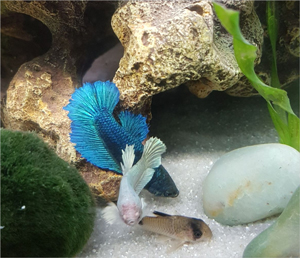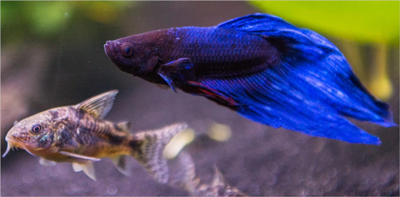
The topic of whether Betta fish should be housed together in a sorority or not seems to be never ending. Some fish enthusiasts warn that in no circumstances other than for strictly breeding should two Bettas ever be tank mates. On the other hand, scientists have conducted a number of tests of the species concluding that Betta females can live happily together with minimal intervention needed. While science can only go so far, we can conclude that it is somewhat safe to create an aquarium space to house a number of Betta females.
While we’ve concluded Betta females can live in harmony (after they have worked out tank hierarchy) the same cannot be said for two male Betta fish. Male Betta fish will become aggressive when placed with another male and this is evident throughout history even earning them their common name; Siamese Fighting Fish. In no circumstances should you ever place two male Bettas within the same tank. If you love the vibrant colors of male Bettas and your heart and wallet is large enough for two, you’ll need to opt for a divided glass tank.
What is Betta Sorority?
A sorority often refers to a group of people or animals who share similar interests or aspirations. In terms of Betta Sororities, these are often 4 or more female Bettas that live together. Basically in short, a group of Bettas. Betta sororities involve some setup and research to ensure they work.
In terms of the tank in which you will keep the sorority, the bigger the better. The more space the Bettas have to swim away from one another, the less chance there will be of heated fights. A 20 to 30 gallon tank is generally sufficient for a Betta sorority.

Male Bettas cannot live in the same aquarium without a divide.
Male and female Bettas should only exist together for breeding purposes.
Female Bettas can live together in a sorority.
Factors that Determine if a Betta Sorority will be Successful
Even today, Betta sororities are very controversial in the fish world. While some owners are strictly against them due to the potential stress that they can cause among individuals within the tank, others have successfully maintained Betta sororities for years. The following factors ultimately determine if a sorority will be successful or not:
- Personality of each Betta Fish
- Size of the Tank/Aquarium
- Plant Coverage and Shelter
- Sorority Introduction
Setting Up a Betta Sorority
Setting up a Betta Sorority can be fun and exciting. Once you selected a tank for your new fish friends, next you’ll need to purchase some gravel or rocks and of course some natural or synthetic plants and Betta toys. The more hide holes and shelter, the less the Betta’s will fight one another. Each Betta in the Sorority will choose their own spot to rest within the tank so ensuring their is a plentiful supply of rest and quiet areas will keep the fighting to a minimum. Of course like any Betta aquarium you’ll also need a filter and medication if any Bettas fall ill.
Betta Sorority Trial and Error
Do not mistake housing Bettas together as simple or easy. Housing fighting fish together takes time and effort. If you have opted for a smaller tank, under 20 gallons you may notice one or two problematic Betta fish. These will appear to be the bullies of the sorority. If you see that one fish has become a bully hurting the others she may need to be removed and housed separately.
A Betta sorority needs to included a certain number of fish to ensure it’s success. Betta enthusiasts suggest that 4 is an ideal number for a sorority. Housing less than 4 Bettas together may lead to one being singled out and continuously bullied. When considering how many Bettas to have you will also need to take in account the size of your tank. In no circumstance should more than 6 Bettas be kept in a 10 gallon tank.
When selecting the Bettas to include in your sorority ensure that they are all female. Only females are able to live within a Betta sorority. When selecting the females, they generally have shorter fins but also have an ovipositor located on their stomach. Younger Betta females show less aggression meaning that a Betta sorority housed together from a young age are more likely to get along. Furthermore, when selecting your Bettas, choose a range of different colored fish. Research shows that female Bettas that look too similar show more aggression to one another.
A successful Betta sorority relies on minimal stress within an aquarium. The less stress placed on each Betta, the greater the chance of a sorority success story.

A minimum of 4 female Bettas should be included in a sorority aquarium.
A sorority tank should be 10 gallons or more.
Choose young and differing colored female Bettas to form a sorority.
Tank Requirements for a Betta Sorority
Before you rush out to buy all the items needed to set up a Betta sorority tank, it is important to first consider the emotional and physical changes the Betta will need to adapt to when being moved from an isolated tank to a shared tank. When a female Betta lives alone, the food pellets sprinkled into their tank or the live food given is entirely theirs. They do not need to compete to eat the food they are given. The shelter within the tank is entirely theirs with no competition for rest areas. This is important to consider when placing a Betta into a sorority. Enough food and shelter should be provided to ensure there is no reason for fish in the sorority to fight.
Stress in fish often leads to a disease outbreak. Ensuring the fish within the sorority do not become stressed is vital in maintaining a happy tank community. Due to the amount of Bettas within the sorority tank, the water quality will also diminish quickly if it is not up kept. Poor water quality will in turn lead to weak Betta immunity and increase their susceptibility to disease.
Minimum Tank Size for a Betta Sorority:
If you plan on housing a Betta sorority you’ll need to ensure you have at a minimum a 10 gallon tank. A tank smaller than 10 gallons is not suitable for a sorority. While a 10 gallon tank is often fine for a sorority of Bettas, the bigger the better. A 20 to 30 gallon tank will only allow the Betta fish more room to swim and hide and in turn mean less bickering will occur. If you are purchasing a tank new for your sorority, a longer tank is always better than a taller tank.
While the Betta fish in a sorority will live within the same tank, each Betta will want to establish their own territory. Whether this be under a rock shelter or the corner of the tank, providing them with enough space to do so is vital. A successful sorority has a plentiful supply of toys and shelter as well as space to move.
Shelter and Toys for a Sorority:
Providing multiple forms of protection within the sorority tank will ensure Betta on Betta fighting is kept to a minimum. Real freshwater plants, synthetic aquarium plants, rocks, driftwood and plastic aquarium shelters are ideal for Betta aquariums. The more shelter within the tank, the better.
Placing Bettas into a Sorority
Once you have set up the aquarium space for your Betta sorority it is time to introduce the new tank mates. Introducing each of your female Bettas at the same time can reduce territorial fighting. If you have purchased the fish from an aquarium, allowing their bubble bags to float along side each other is a great way to introduce the new friends. After 10 or so minutes slowly release each Betta into the aquarium space.
When Betta females meet one another some bickering may occur. While a small amount of aggression is common for the first couple of days in a Betta sorority tank, it is important to pay attention to ensure there is not a weak female who may fall ill at the hands of an aggressor in the tank. If you see one Betta constantly bullying others within the tank you may need to intervene and remove the fish to ensure the others are not antagonized.
If you cannot successfully house your female Bettas together, more than likely it is the personality of the individual Bettas opposed to the set up. Some Bettas tend to be extremely territorial while at the other end of the spectrum, some Bettas are mellow and due to this become targeted by other tank mates.
After ten or so minutes of the aggressive tank mate being removed, you can attempt to reintroduce that Betta to the sorority. If she persists to show aggressive behavior towards the other fish, she may need to be kept in an isolated tank.
Once you have set up your Betta sorority and all fish are living within the community happily, ensure you:
- Complete weekly 25% water changes to ensure water quality is maintained.
- Remove any Bettas that fall ill as soon as possible.
- Feed your sorority the right amount of food to ensure wastage does not rot at the bottom of the aquarium.
- Ensure the correct filter is being used to maintain water quality and remove waste from the tank.
Further Tank Mates for a Betta Fish
If you have tried a Betta sorority and have unfortunately not had much success, you may want an alternative fish friend for you beloved Betta. Just because another female Betta was not the perfect fit, does not mean that your Betta has to live alone. Betta females can also be housed with the following aquatic species:
- Mystery snails
- Ghost Shrimp
- Catfish
- African Dwarf Frogs
- Guppies
- Tetras
Read more about alternative Betta Tank Mates here.

Bettas can be housed with a number of other aquatic species.
Ensure you consider the effect a Betta sorority: ammonia levels, water quality and the amount of food supplied.
Risks Associated with a Betta Sorority Tank
While many fish enthusiasts are able to have a happy and healthy Betta sorority tank, these tanks take patience and often expertise. If you are a first time fish owner, a Betta sorority is not the place to start. Housing any two territorial animals together takes work and Betta females are no exception. While the females within this breed are far less aggressive than the males, they will always be a territorial fish breed. This means that if the sorority is not monitored, things can turn nasty. For instance, if one Betta female bullies another and bites their fin, fin rot can occur. Furthermore, if one Betta is being bullied they may not be able to access food and become malnourished or if left long enough, the Betta may starve.
Just like any number of fish kept in the same aquarium, the up keep is much greater than having one fish. The tank will need to be cleaned regularly to keep the ammonia levels down and the inhabitants happy. Bettas can happily live in a sorority although this can only be a possibility if the fish owner is vigilant and maintains the aquarium space.
If you are a first time fish owner, consider keeping one Betta before considering a sorority.
When to Split Up a Betta Sorority
While a Betta sorority can work, some just don’t. If you have set up an aquarium with hopes of starting a Betta sorority to only find your fish are fighting, don’t loose heart. If after one week the female Bettas are continuing to show aggression to one another (that is causing noticeable harm) it is time to break the sorority up. Bettas are aggressive by nature and some tend to be more aggressive than other. If you find that your sorority is just not working, chances are you’ve picked a bunch of highly aggressive Bettas. If you own a handful of tanks you aren’t using, separate your Bettas out. If you don’t own enough tanks, it may be time to sell off some of your Bettas or see a family or friend would like to own a fish friend as well.
Hi, could I fit a BABY sorority tank in a 6.5 gallon tank?
Hi,
We recommend using a tank that is 10 gallons or larger unless the tank is relatively shallow and long to allow the Bettas to dominate their own spaces.
I am setting up a 36 gallon tank. How many female betas could I get to put in the tank?
A 36 gallon tank is a good size for keeping multiple bettas. However, it’s important to keep in mind that female bettas can still be territorial and aggressive towards each other. It’s generally recommended to keep female bettas in groups of at least 5 or 6 to help spread out aggression and establish a hierarchy.